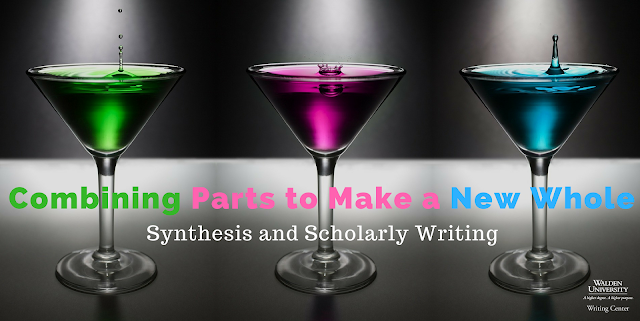Synthesis and Scholarly Writing Part 2: Putting Synthesis to Work
In Part 1 of this blog series, Katherine discussed the definition of synthesis and its importance to scholarly writing. This week, Katherine suggests methods of synthesizing information and provides examples and additional resources for improving synthesis in writing.
When writers synthesize information, they combine their own
interpretations and ideas with those existing in the current literature to
create new avenues for discussion and research. However, because synthesis is
very specific to a piece of writing and the sources used in that writing,
improving synthesis is not as straightforward as, say, improving the APA formatting of a document. Writers with different experiences and
perspectives will synthesize information in different ways. For example, take
the two following pieces of information:
- In 2007, 21.3% of youths in the state of Georgia were categorized as being obese (Child and Adolescent Health Measurement Initiative [CAHMI], 2007).
- In the state of Georgia, 16% of youths were categorized as being obese in 2011 (CAHMI, 2011).
One scholar might take these two pieces of information and
argue that legislators in Georgia are not doing enough to combat obesity in
childhood, while another might argue that state initiatives to decrease obesity
in children are working. The same information can be synthesized in different
ways, which is why improving synthesis can seem difficult. With that said,
there are a couple of overarching methods that writers can use to synthesize
information in writing.
As discussed in Part 1, it is important to remember that
synthesis often involves building upon the ideas in prior research. When
writing a paper, scholars should remember that they are not just repeating what
was said in research but instead using research as a foundation for their arguments.
Because of this, scholars may want to approach the sources that they use in
writing a paper in one of two ways:
The first approach is to read the text as a judge of its
scholarly value.
In other words, you can read a scholarly article and ask
yourself questions about how the study was designed, the sample size, the
conclusions drawn from the information gathered, etc. How does each element of
the scholarly article match up to what you know about scholarly writing? Answering this question can help you decide how you feel about the
source, which will also help you decide how you would like to use it in your
writing. If you come up with positive answers to this question, you can use the
source to support your argument. If you find flaws in the study, you can
discuss how to improve future studies on the topic or compare the source to
stronger studies on the same topic.
The second approach is to read the text with your own theory
or experiences in mind (or with theories and evidence from prior research in
mind).
This approach is where your experiences as a scholar practitioner
will come in handy! You can also read texts with your practical experiences or
theories in mind. If prior research has convinced you of a theory, you can read
other articles with that theory in mind in order to see how the authors’
positions align with prior research. While you should always allow room for
your perspective to change when reading scholarly articles, using your own
experiences as a starting point when reading can help you synthesize source
information when you write.
Now that you know a couple of approaches that can help you
synthesize information at a global level, what does synthesis look like within
a text at the local (or paragraph) level? Let’s look at a couple of example
sources to begin:
- The owners of small businesses who followed the theory of financial management reduced business costs by 12% (Ang, 2016).
- The owners of small businesses who followed the theory of financial management reduced business costs by 17% (Sonfield, 2015).
Taken together, it appears that these sources support each
other, so synthesizing this information within a paragraph might look something
like this:
Ang (2016) found that the owners of small businesses who followed the theory of financial management reduced business costs by 12%, while Sonfield (2015) found that this theory reduced costs at small businesses by 17%. These studies together confirmed that adopting the theory of financial management reduces costs for small businesses in the U.S.
The highlighted phrases show how writers can position these
two pieces of source material while illustrating their overall ideas about the
source. Once again, though, context is important in synthesis. Let’s say the
writer was only able to find the above two sources about the theory of
financial management. In that case, synthesis might look like this:
Although Ang (2016) found that the owners of small businesses who followed the theory of financial management reduced business costs by 12% and Sonfield (2015) found that this theory reduced costs at small businesses by 17%, more research is needed to determine whether this theory reduces costs for other types of businesses.
As mentioned before, the perception and experiences of a scholar-practitioner are incredibly important to synthesis. Through your perception of the scholarly articles you read, you will create arguments that illustrate the connections between sources and your own ideas. This will allow you to build on the foundation of research and eventually conduct your own research. Although I’ve provided suggestions and examples above, synthesis depends upon your experiences and ideas. Do you have any tips for improving synthesis in writing? Please feel free to share them below!
Katherine McKinney is a writing instructor in the Walden University Writing Center. She received an M.A. in English from Valdosta State University in Valdosta, Georgia, and is currently pursuing a Ph.D. in Education at Walden. Katherine's goal as an instructor is to show students that the best writing results from practice, and she aims to provide feedback and resources that will guide students through the invention, composition, and revision process.
.png)
Never miss a new post; Opt-out at any time
Subscribe to:
Post Comments
(
Atom
)





Thanks for the info. The above examples of synthesizing that you did above were from macro to micro. Synthesizing could also be done from micro to macro; from general to specific and vice versa. Again, the backdrop, from your own research or experience.
ReplyDeleteWe’re glad you liked the post, NGPalmore! There are definitely different ways in which papers might be organized and resources synthesized.
ReplyDelete